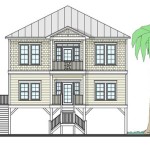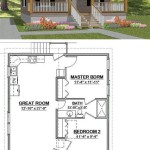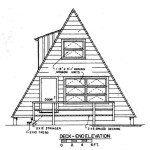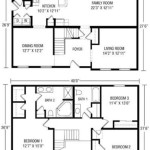House plans, also known as blueprints, are the detailed drawings and specifications that serve as the roadmap for constructing a building. They provide a comprehensive representation of the structure’s layout, dimensions, materials, and systems, allowing architects, engineers, contractors, and homeowners to visualize and understand the design intent.
Reading house plans is a valuable skill for anyone involved in the construction or renovation process. It enables homeowners to understand the proposed design, make informed decisions, and effectively communicate with contractors. For contractors, it’s crucial for accurate bidding, scheduling, and project execution. Therefore, having a basic understanding of how to read house plans is essential for ensuring a successful building project.
In this article, we will delve into the key aspects of reading house plans, providing guidance on understanding different sections, symbols, and notations. By following the steps outlined in this article, you can gain the confidence and knowledge to navigate house plans effectively and make informed decisions throughout your building project.
To effectively read house plans, it’s essential to understand the following eight key points:
- Identify the scale
- Understand symbols and abbreviations
- Interpret floor plans
- Read elevations
- Examine sections
- Analyze details
- Review schedules and specifications
- Consider site plans and landscaping
By mastering these aspects, you can develop a comprehensive understanding of house plans, enabling you to make informed decisions and communicate effectively during the construction process.
Identify the scale
The scale of a house plan is a crucial element to understand, as it determines the relationship between the dimensions on the plan and the actual size of the building. Scales are typically expressed as a ratio, such as 1:50 or 1/4 inch = 1 foot. This means that for every unit of measurement on the plan, the corresponding actual measurement is 50 times or 4 inches, respectively.
Accurately identifying the scale is essential for understanding the true dimensions of the building and its components. For example, if a wall is shown as 10 units long on a plan with a scale of 1:50, the actual length of the wall would be 500 units (10 units x 50). Similarly, if a window is shown as 2 units wide on a plan with a scale of 1/4 inch = 1 foot, the actual width of the window would be 8 inches (2 units x 4 inches).
Plans may include multiple scales to accommodate different levels of detail. For instance, a small-scale plan may provide an overview of the entire building, while larger-scale plans may focus on specific areas, such as individual rooms or building systems. Understanding the scale of each plan is crucial to interpreting the information correctly.
To ensure accurate measurements, it’s important to use the correct scale when taking dimensions from the plan. This can be done using a scale ruler or by calculating the dimensions based on the provided scale ratio. By carefully considering the scale of the plan, you can gain a precise understanding of the building’s dimensions and avoid costly errors during construction.
Understand symbols and abbreviations
House plans utilize a standardized set of symbols and abbreviations to convey information concisely and efficiently. Understanding these symbols and abbreviations is essential for accurately interpreting the plans and ensuring a clear understanding of the design intent.
Symbols are used to represent various building components, such as walls, doors, windows, plumbing fixtures, and electrical outlets. Each symbol is carefully designed to convey specific information about the component’s type, size, and location. For example, a square with a diagonal line may represent a door, while a circle with a cross inside may indicate a light fixture.
Abbreviations are commonly used to denote materials, construction methods, and building codes. For instance, “CMU” may stand for concrete masonry unit, “OSB” for oriented strand board, and “IBC” for International Building Code. Understanding these abbreviations allows you to quickly grasp the specified materials and construction practices.
To effectively read house plans, it’s crucial to familiarize yourself with the common symbols and abbreviations used in the industry. Many resources are available to assist you, including online libraries, reference books, and software tools. By investing time in learning these symbols and abbreviations, you’ll gain a deeper understanding of the plans and be able to communicate more effectively with architects, contractors, and other professionals involved in the building process.
Here are some common examples of symbols and abbreviations used in house plans:
- Symbol for a door: A square with a diagonal line
- Symbol for a window: A square or rectangle with a horizontal line inside
- Symbol for a wall: A thick line
- Symbol for a plumbing fixture: A circle or square with a specific shape inside to indicate the type of fixture (e.g., sink, toilet, shower)
- Symbol for an electrical outlet: A small circle
- Abbreviation for concrete masonry unit: CMU
- Abbreviation for oriented strand board: OSB
- Abbreviation for International Building Code: IBC
By understanding these symbols and abbreviations, you’ll be well-equipped to navigate house plans confidently and make informed decisions throughout your building project.
Interpret floor plans
Floor plans are one of the most important components of a house plan set. They provide a detailed overview of each level of the building, showing the layout of rooms, walls, doors, windows, and other features. Interpreting floor plans accurately is crucial for understanding the spatial relationships within the building and ensuring that the design meets the intended purpose.
To effectively interpret floor plans, it’s essential to pay attention to the following details:
- Room layout: The floor plan clearly outlines the arrangement of rooms within each level. Identify the different types of rooms, such as bedrooms, bathrooms, living areas, and kitchens. Note their and how they connect to each other.
- Wall placement: Walls are represented by thick lines on the floor plan. Pay attention to the location and orientation of walls, as they define the shape and size of each room. Identify load-bearing walls, which are thicker and support the weight of the building.
- Door and window placement: Doors and windows are indicated by symbols on the floor plan. Note their location and dimensions to understand how they provide access to and natural light for each room.
- Measurements: Floor plans typically include measurements for walls, doors, windows, and other features. These measurements are crucial for determining the actual size and proportions of the building.
Once you have a clear understanding of the individual elements, you can start to interpret the overall flow and functionality of the floor plan. Consider the following aspects:
- Circulation: Analyze how people will move through the building. Are there clear and efficient paths between rooms and different levels?
- Privacy: Pay attention to the placement of private areas, such as bedrooms and bathrooms, to ensure they offer the desired level of privacy.
- Natural light: Consider how natural light will enter the building through windows and skylights. Is there sufficient natural light in all areas of the building?
- Overall layout: Evaluate the overall layout of the floor plan to determine if it meets your needs and preferences. Consider factors such as room sizes, adjacencies, and the relationship between different spaces.
By carefully interpreting floor plans, you can gain valuable insights into the design and functionality of the building. This understanding is essential for making informed decisions during the planning and construction process.
Read elevations
Elevations are two-dimensional drawings that depict the vertical aspects of a building. They show the height, shape, and architectural details of the exterior walls, as well as the relationship between different levels of the building.
To read elevations effectively, it’s crucial to understand the following key elements:
- Vertical measurements: Elevations typically include vertical measurements, such as the height of walls, windows, and doors, as well as the overall height of the building. These measurements help determine the scale and proportions of the building.
- Exterior details: Elevations showcase the architectural details of the exterior walls, including windows, doors, cladding materials, and decorative elements. Pay attention to the style, size, and placement of these features to understand the overall aesthetic of the building.
- Rooflines: Elevations clearly illustrate the shape and pitch of the roof, as well as the location of chimneys, vents, and other roof elements. This information is essential for understanding the drainage and structural aspects of the building.
Reading elevations allows you to visualize the three-dimensional form of the building and gain insights into its architectural style and character. It’s particularly useful for understanding how the building will appear from different angles and how it will fit into its surrounding environment.
Furthermore, elevations are crucial for contractors and builders, as they provide detailed information for constructing the exterior walls and ensuring the proper installation of windows, doors, and other components.
Examine sections
Sections are vertical slices through a building that reveal the interior construction and layout. They provide detailed information about the building’s structure, materials, and finishes. Examining sections is essential for understanding the three-dimensional aspects of a building and ensuring that all components work together seamlessly.
- Structural elements: Sections show the location and dimensions of structural elements, such as beams, columns, and walls. This information is crucial for understanding how the building supports its own weight and external forces.
- Material layers: Sections reveal the different layers of materials used in the construction of walls, floors, and ceilings. This includes layers of drywall, insulation, sheathing, and framing. Understanding the material layers is important for assessing the building’s thermal performance, soundproofing, and fire resistance.
- Mechanical, electrical, and plumbing systems: Sections indicate the location and routing of mechanical, electrical, and plumbing systems within the building. This includes pipes, ducts, wires, and fixtures. Examining these systems is essential for ensuring that they are properly installed, accessible for maintenance, and do not interfere with other building components.
- Finishes and details: Sections also show the types of finishes and details used in the building, such as flooring, wall coverings, moldings, and cabinetry. This information is important for understanding the aesthetic and functional aspects of the building’s interior.
By carefully examining sections, you can gain a comprehensive understanding of the building’s construction, systems, and finishes. This knowledge is invaluable for architects, engineers, contractors, and homeowners alike, as it enables them to make informed decisions during the design, construction, and renovation processes.
Analyze details
Analyzing the details of a house plan is crucial for understanding the intricate aspects of the design and ensuring that the building meets the desired functionality and aesthetic requirements. Details include precise measurements, material specifications, construction techniques, and finishes. Careful examination of these details enables architects, contractors, and homeowners to make informed decisions and avoid costly errors during the construction process.
- Dimensions and measurements: House plans include precise dimensions and measurements for all aspects of the building, including walls, doors, windows, and structural elements. These measurements are essential for accurate construction and ensuring that all components fit together seamlessly. Verifying dimensions and measurements helps avoid costly mistakes and ensures the structural integrity of the building.
- Material specifications: House plans specify the materials to be used for different components of the building, such as framing, roofing, siding, flooring, and finishes. Understanding the material specifications is crucial for ensuring that the building meets the desired performance criteria, such as durability, energy efficiency, and fire resistance. It also helps in budgeting and procurement during the construction phase.
- Construction techniques: House plans often include details on specific construction techniques to be employed, such as framing methods, insulation techniques, and roofing systems. Understanding these techniques is essential for ensuring that the building is constructed according to industry standards and best practices. It helps contractors and builders avoid potential structural issues and ensures the longevity of the building.
- Finishes and details: House plans provide information on the finishes and details to be used in the building, such as flooring materials, wall coverings, moldings, and cabinetry. These details contribute to the aesthetic appeal and functionality of the building. Analyzing these details helps ensure that the finished building aligns with the design intent and meets the desired style and quality.
Thoroughly analyzing the details of a house plan is essential for ensuring a successful building project. It enables architects, contractors, and homeowners to fully understand the design, make informed decisions, and avoid costly errors during construction. By carefully examining the details, all parties involved can work together to create a building that meets the intended purpose, aesthetic vision, and performance requirements.
Review schedules and specifications
In addition to the graphical representations of the house plan, it is essential to review the accompanying schedules and specifications to gain a comprehensive understanding of the project. These documents provide detailed information about the materials, finishes, and construction methods to be used, ensuring that the building meets the desired quality and performance standards.
- Material schedules: Material schedules list all the materials required for the construction of the building, including quantities, dimensions, and specifications. They provide a clear understanding of the types and amounts of materials needed, enabling accurate budgeting and procurement. Material schedules also help ensure that the materials used are compatible with each other and meet the design intent.
- Finishes schedules: Finishes schedules specify the materials and methods to be used for interior and exterior finishes, such as flooring, wall coverings, paint, and hardware. These schedules provide detailed information about the colors, textures, and patterns of the finishes, ensuring that the building’s aesthetic vision is realized. Finishes schedules also help coordinate the selection and installation of different finish materials, avoiding potential clashes or inconsistencies.
- Construction specifications: Construction specifications provide detailed instructions on how the building is to be constructed, including specific methods, techniques, and quality standards. These specifications cover various aspects of construction, such as framing, roofing, insulation, electrical, plumbing, and HVAC systems. By outlining the required construction practices, specifications ensure that the building is built according to industry standards and best practices, resulting in a safe, durable, and functional structure.
- Equipment schedules: Equipment schedules list the appliances, fixtures, and equipment to be installed in the building, including their specifications, quantities, and locations. These schedules provide a clear understanding of the types and quantities of equipment required, enabling proper planning for installation and maintenance. Equipment schedules also help ensure that the building is adequately equipped to meet the needs of its occupants.
Carefully reviewing schedules and specifications is crucial for architects, contractors, and homeowners alike. These documents provide valuable information that complements the graphical representations of the house plan, ensuring a comprehensive understanding of the project. By thoroughly examining schedules and specifications, all parties involved can work together to create a building that meets the desired functionality, aesthetic appeal, and performance criteria.
Consider site plans and landscaping
Site plans and landscaping play a crucial role in the overall design and functionality of a building project. They provide a comprehensive overview of the relationship between the building and its surrounding environment, ensuring that the structure is well-integrated into its context and meets the desired aesthetic and functional requirements.
Site plans: Site plans are detailed drawings that depict the layout of the building on the property, including its orientation, setbacks, and relationship to existing structures, roads, and utilities. They provide valuable information for understanding how the building will fit into the site and how it will impact the surrounding environment. Site plans also help determine the best placement of driveways, walkways, patios, and other exterior features, ensuring efficient and accessible circulation around the building.
Landscaping: Landscaping plans outline the design and installation of plants, trees, and other landscape elements around the building. These plans consider factors such as soil conditions, drainage, sunlight, and the desired aesthetic effect. Landscaping plays a vital role in enhancing the building’s visual appeal, creating outdoor living spaces, and providing privacy and noise reduction. Well-executed landscaping can seamlessly integrate the building into its surroundings, creating a harmonious and inviting environment.
Site and landscaping considerations: When considering site plans and landscaping, it is essential to evaluate various factors, including:
- Orientation: The orientation of the building on the site can impact its energy efficiency, natural lighting, and views. Careful consideration of the sun’s path and prevailing winds can help optimize the building’s performance and create comfortable and inviting spaces.
- Grading and drainage: Proper grading and drainage systems are crucial for managing water flow around the building and preventing flooding or erosion. Site plans should include detailed information on grading, drainage patterns, and the location of drainage systems.
- Access and circulation: Site plans should ensure that the building is easily accessible from roads and walkways. They should also consider the flow of traffic around the building, including pedestrian and vehicular circulation, to create a safe and efficient environment.
- Privacy and screening: Landscaping can play a vital role in providing privacy for the building’s occupants and screening unsightly views. The placement of trees, shrubs, and other landscape elements can help create private outdoor spaces and reduce noise pollution.
- Sustainability: Site plans and landscaping can incorporate sustainable practices to minimize the environmental impact of the building. This includes using native plants, utilizing rainwater harvesting systems, and implementing energy-efficient lighting solutions.
By carefully considering site plans and landscaping, architects, contractors, and homeowners can create buildings that are well-integrated into their surroundings, meet the desired functional and aesthetic requirements, and promote sustainability and harmony with the natural environment.










Related Posts








